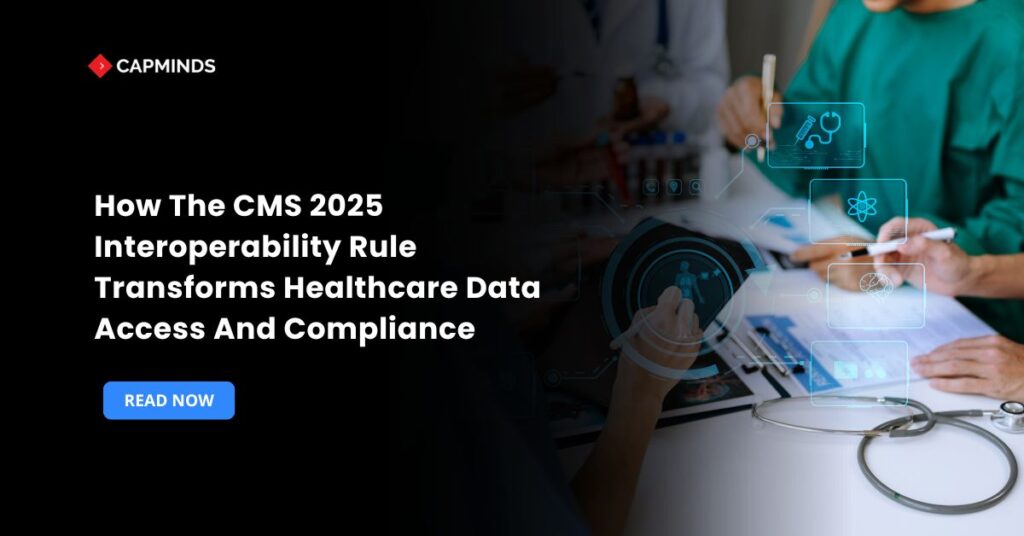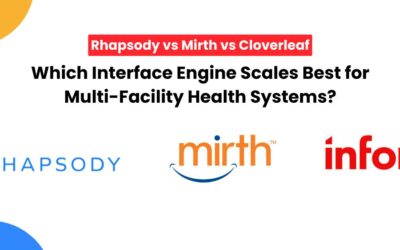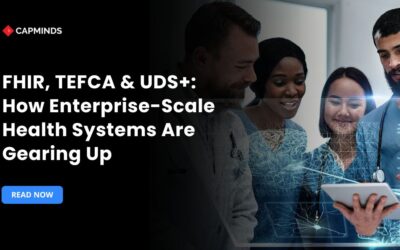How The CMS 2025 Interoperability Rule Transforms Healthcare Data Access And Compliance
Healthcare data is separated, preventing patients and providers from accessing important information when required. This inaccessibility causes frustration, wastes time, compromises safety and raises expenses.
Missing or delayed data can result in unnecessary testing, prescription mistakes, disconnected treatment, and burdening physicians. CMS has issued regulatory mandates that compel payers to adopt secure, standards-based APIs for claims and clinical data sharing.
In this blog, you’ll know the 2025 updates to CMS’s interoperability framework and how healthcare stakeholders can align for compliance and innovation.
CMS Interoperability in Healthcare
Interoperability in healthcare refers to the ability of various information systems, devices, and applications to access, share, integrate, and use data in a coordinated manner. CMS interoperability specifically targets data-sharing requirements for CMS-regulated payers such as Medicare Advantage, Medicaid, CHIP, and QHPs on the Exchange.
The goal is to break down information silos so that patients and approved third-party apps may readily get claims and clinical data to help with decision-making and care continuity.
Key Features Include
- Standards-based Data Exchange – Involves using HL7 FHIR APIs to develop a uniform data model.
- Security and Privacy – Data protection is ensured using the OAuth 2.0 and OpenID Connect login and authorization protocols.
- Patient Empowerment – Giving people convenient, digital access to their health information, allowing them to share it with the applications or providers of their choosing.
Understanding the CMS Patient Access Rule
CMS’ Patient Access Final Rule focuses on two main pillars
Consumer Access via APIs
Payers must provide FHIR-based APIs that allow patients to see their claims and encounter data, as well as provider directory information.
Data Exchange Between Payers
To provide continuity during insurance changes, the Payer-to-Payer Exchange mandates that payers provide clinical and claims information to their new payers upon request from the patient.
By combining these pillars, the regulation hopes to eliminate administrative friction while providing customers more influence over their healthcare experience.
What’s New in the 2025 Final Rule?
The 2025 edition of the regulation expands on the 2020 framework, clarifying standards and tightening timeframes to encourage widespread implementation.
API Data Access Requirements
Payers must provide two standard APIs.
- Patient API – Provides authorized patients with direct access to their current and previous claims and healthcare data via third-party applications.
- Provider Directory API – This API publishes up-to-date provider directory information so that patients may find in-network providers via applications.
Third-Party Application Access
To encourage innovation, CMS mandates payers to enroll at least two widely used third-party applications, giving patients direct access to established digital health solutions rather than creating new portals.
Other requirements
- Annual Data Refresh – Payers are required to refresh data feeds every 24 hours.
- Error Reporting and Monitoring – A consistent structure for logging, error codes, and uptime monitoring provides dependability.
- Patient Education – Payers must give plain-language notices to patients regarding their API rights and how to use them.
Continuous Compliance
- By August 31, 2025, all payers must submit their yearly API compliance certification, which must include performance information from July 2024 to June 2025.
- In July 2025, CMS issued Civil Money Penalties on noncompliant payers, which may range from $50,000 to $250,000, depending on the duration and severity of outages.
- As part of the 2025 updates, performance reporting includes monthly measurements on API error rates, latency, and data refresh times that must now be publicly available on payer websites.
Related: FHIR + OpenEMR: Enabling Modern Interoperability in 2025
Benefits for Stakeholders
1. Patients
- Patients can access real-time health data via secure digital applications, allowing them to make informed decisions.
- Providing both patients and doctors with comprehensive medical histories helps to avoid duplicate processes such as unneeded testing or paperwork.
- Patients report higher levels of satisfaction, more trust in the healthcare system, and more control over their health journey.
2. Providers
- Healthcare professionals will no longer have to rely on outdated techniques such as fax or handwritten requests to access patient information, saving time and minimizing administrative load.
- Improved onboarding protocols allow providers to easily access new patients’ clinical and claim information, guaranteeing continuity of treatment without delays.
- Improved access to complete data provides deeper clinical insights, allowing doctors to make more precise diagnoses and treatment decisions.
3. Payors
- Payers will profit from fewer inbound support calls for claims queries and data access since patients may get information independently via APIs and third-party applications.
- The reduced reliance on manual processes results in lower administrative costs, allowing payers to deploy resources more effectively.
- Payers may enhance member satisfaction and establish closer ties with patients and providers by allowing for more seamless digital interaction.
4. Developers
- Developers may use HL7 FHIR-based APIs to create novel healthcare apps that address the rising need for digital health solutions.
- With standardized data sets from numerous payers and providers, developers may construct more sophisticated and impactful solutions for both patients and clinicians.
- This improved environment fosters speedier innovation, allowing technology suppliers to provide cutting-edge solutions that improve healthcare access, quality, and efficiency.
Challenges and Considerations
Technical Complexity – Creating and maintaining FHIR-based APIs demands specialized knowledge and a strong infrastructure.
Data Quality and Consistency – Coding errors and missing data might make it difficult to integrate systems seamlessly.
Security Risks – While OAuth 2.0 and OpenID Connect provide significant protections, the fast growth of API endpoints creates new attack vectors.
Adoption Barriers – Smaller payers and rural providers may not have the resources to adopt and optimize APIs at scale.
Best Practices in Compliance
- Early vendor collaboration helps to coordinate with providers of RCM, API platforms, and EHRs to align with technology roadmaps.
- Sturdy testing frameworks of every API endpoint from end to end, as well as for security and load.
- Data governance programs enhance data integrity, standardize code, and data validation procedures, and master data management strategies.
- Patient-centric UX design helps to develop apps and portals powered by APIs that have user-friendly, transparent interfaces that put an emphasis on patient education and accessibility.
- Continuous monitoring and feedback of real-time dashboards assess incoming error reports promptly and make adjustments based on input from patients and developers.
Related: Building UDS, MIPS, and PCMH Reports the Smart Way
Health Interoperability Solution from CapMinds
If you’re seeking the optimal solution for Interoperability & EHR to facilitate the secure exchange of healthcare information and data, look no further.
CapMinds has a team of experts in Interoperability who specialize in linking any health system using world-class protocols such as HL7, FHIR, SMART, RIS, PACS, Lab, eRX, Payor, Payment, and more.
Healthcare organizations and clinicians can reach new heights by automating their processes with our cutting-edge, intelligent, and innovative digital health technologies. This assures 100% improved documentation and advanced health interoperability.
Reach out to CapMinds for enhanced security and protection in your interoperability and data exchange.




